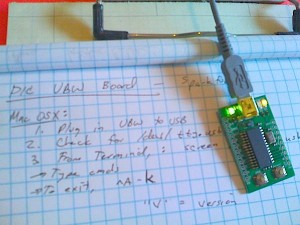Building on the previous two mini-projects, I have a mini-graphical data acquisition project now running under the Processing language, getting real-world signals from the USB microcontroller (which is a Microchip PIC on a UBW Board from Sparkfun). Source code below the screenshot.
Month: March 2009
Analog Data Acquisition from USB Microcontroller using the “Processing” Language
Blinky LED ‘Hello World’ using USB Microcontroller in ‘Processing’
Every good embedded systems hardware project begins with a blinking LED (or toggling level as seen on the oscilloscope). In Processing.org language, there’s the opportunity for both, since the built-in graphics allow for data display as well as the USB microcontroller interface. (There’s several Processing projects for Arduino, BTW.) Source code is below.
Using the Processing.org Language with Microcontrollers
Media-technology engineers at MIT have created a computer language and easy-to-use runtime environment called Processing, hosted at processing.org. I wrote a small code snip for accessing the PIC microcontroller from a USB port, using Processing; it’s pasted below.
Apple iPhone 3.0 as next generation Biomedical device
Apple’s developer preview today, of iPhone 3.0 software, included the interesting news of support for external accessories, either connected through the physical docking connector or through Bluetooth wireless.

A spokesman from Johnson & Johnson announced an iPhone-blood-pressure-monitor accessory, which provides health biometrics and allows the biometrics to be sent over the iPhone’s network connection as an emergency alert. Their goal is to make diabetes monitoring easier.
The details of the new iPhone interface are in a thin draft document, External Accessory Framework Reference. This doesn’t include the hardware details necessary to connect arbitrary devices, though once it does, I’ll be hooking lots of different devices to the “iPhone-smart-phone-turned-general-purpose-minicomputer”.
I’m sure the game companies already have external joysticks in the works. A recent interview with Pangea software owner revealed their earnings of $1.5 million from downloads of a single iPhone game (Enigmo), with over 800,000 downloads. His biggest complaint: “no D-pad game controller.” Rest assured, that will be solved soon.
Games aside, the iPhone (or iTouch) offers a solid software environment which includes graphical presentation, ease of data entry, network support, wireless roaming, audio support, and now external device data accessories. This is exactly the kind of tool that medical and bioscience needs to help with a deluge of patients.
Synthetic Biology Conference 4.0 videos now online
Videos of the Synthetic Biology Conference 4.0 from Hong Kong are now available.
One of the best all-around talks as an introduction to synthetic biology, and biotech business aspects of syn bio, is the lecture by Amyris Technologies, and an antidote for malaria using synthesis of the precursors to artimesinin; watch the video below.
Amyris’s Artemisinin Project is completely not-for-profit. The company received a large grant from the Gates Foundation for this commercializable research.
The talk also includes a discussion regarding biofuel breakthroughs now possible through syn bio techniques; their project is currently ramping up to make biodiesel sugarcane bioreactors in Brazil.
Everyone Needs a PCR Machine
In the early 1970’s, groups of nerdy engineers with hacked-up electronics would meet at “homebrew computing clubs” to share technology and share the vision of a world where “everyone has a home computer for running personal software.” A couple of these guys like Steve Wozniak and Steve Jobs were part of the tornado, and look around today to marvel at the innovation created. Neither Steve anticipated or guessed that the first personal spreadsheet program, Visicalc, meant for small business and personal finance management, would serve as a catalyst for the rapid rise in adoption of personal computers.
Today, groups of nerdy bioengineers with hacked-up hardware are meeting at “DIYBio” clubs to share technology and share the vision of a world where “everyone has biotech tools for making personal biology.” Mark the calendar: the wave has just begun.
Stanford University: Programmable Microfluidics (2007) – Video
October 3, 2007 lecture by Bill Thies for the Stanford University Computer Systems Colloquium (EE 380). Bill Thies provides an overview of microfluidic technologies from a computer science perspective, highlight areas in the which computer science researchers can contribute to this field; he will also describe recent work in developing new architectures, programming languages, and CAD tools for the microfluidic domain.
EE 380 | Computer Systems Colloquium:
http://www.stanford.edu/class/ee380/


